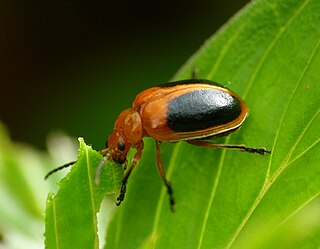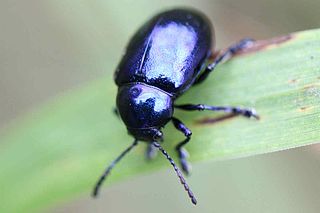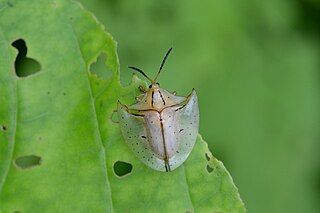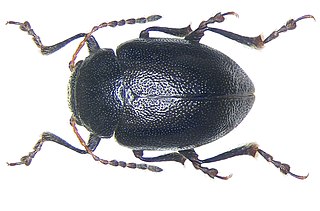
Oniticellus is a genus of dung beetles in the subfamily Scarabaeinae of the scarab beetle family.

Bromius obscurus, the western grape rootworm, is a species of beetle in the leaf beetle family. It is the only member of the genus Bromius. The distribution of the species is holarctic; it can be found in North America, wide parts of Europe, and Asia. The species is a known pest of grape vines in Europe and western North America.

Oides is a genus of leaf beetle with nearly 40 species in the Oriental and Palearctic Realms.

Calligrapha is a large genus of American Chrysomelinae, with over 100 species occurring from North America through Central America.

Colposcelis is a genus of darkling beetles in the subfamily Pimeliinae. Species have a palaearctic distribution in Asia.

Chrysochus is a genus of leaf beetles in the subfamily Eumolpinae. It is known from North America, Europe and Asia.
Edusella is a genus of leaf beetles in the subfamily Eumolpinae. It mainly occurs in Australia, with a single species occurring in New Caledonia.

Euryphagus is a genus of longhorn beetles native to tropical Asia. It is classified in the family Cerambycidae, subfamily Cerambycinae, and the tribe Trachyderini. The generic name is derived from Greek εὐρύς and φαγεῖν referring to the broad mandibles of the males.
Eurycephalus is an invalid longhorn beetle generic name first published by the British zoologist John Edward Gray in 1831. It is now considered to be a junior objective synonym of the genus Tapeina established by the French entomologists Amédée Lepeletier and Jean Guillaume Audinet-Serville in 1828. Several other organisms were also named Eurycephalus by other zoologists that have since been invalidated. They are listed below with their current accepted name:

Heteraspis is a genus of leaf beetles in the subfamily Eumolpinae. The genus includes over 70 species, mainly from the Afrotropical, Palearctic and Oriental biogeographic realms. Only three species are found in Australia.

Chrysochus asclepiadeus is a member of the leaf beetle subfamily Eumolpinae. It is considered the type species of the genus Chrysochus, though it has sometimes been placed within the genus Eumolpus. It is the only species of Chrysochus distributed in the western Palaearctic. It is mainly found in Europe, though it is also known from Kazakhstan and Turkey in Asia.
Endocephalus is a genus of leaf beetles in the subfamily Eumolpinae. It is distributed in South America.

Ampedus is a genus of click beetles in the family Elateridae. There are currently 461 recognized species of Ampedus beetles. It has a cosmopolitan distribution, but is found mostly in the Holarctic region, primarily in North America, Europe, and Asia. The oldest known fossil from this genus was found in Eocene Baltic amber, estimated to be from 38.0 to 33.9 million years ago.

Bromiini is a tribe of leaf beetles in the subfamily Eumolpinae. The tribe contains approximately 120 genera, which are found worldwide. They are generally thought to be an artificial group, often with a subcylindrical prothorax without lateral ridges and covered with setae or scales.

Coptocephala is a genus of beetles belonging to the family Chrysomelidae. The genus was first described by Louis Alexandre Auguste Chevrolat in 1836.
Odontionopa is a genus of leaf beetles in the subfamily Eumolpinae. It is distributed in Africa.

Acromis is a genus of beetles belonging to the family Chrysomelidae. The three species of this genus are found in Southern America. These species exhibit subsociality, where the females lay clusters of eggs that she guards until they hatch, the larvae mature, pupate, and young adults disperse.

Coelomera is a genus of beetles belonging to the family Chrysomelidae.

Pimeliini is a tribe of darkling beetles in the subfamily Pimeliinae of the family Tenebrionidae. There are more than 60 genera in Pimeliini, found primarily in the Palearctic.

Colaspidema is a genus of leaf beetles in the subfamily Chrysomelinae.














